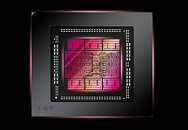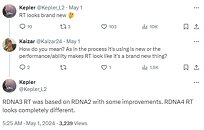- Joined
- Oct 9, 2007
- Messages
- 47,655 (7.44/day)
- Location
- Dublin, Ireland
| System Name | RBMK-1000 |
|---|---|
| Processor | AMD Ryzen 7 5700G |
| Motherboard | Gigabyte B550 AORUS Elite V2 |
| Cooling | DeepCool Gammax L240 V2 |
| Memory | 2x 16GB DDR4-3200 |
| Video Card(s) | Galax RTX 4070 Ti EX |
| Storage | Samsung 990 1TB |
| Display(s) | BenQ 1440p 60 Hz 27-inch |
| Case | Corsair Carbide 100R |
| Audio Device(s) | ASUS SupremeFX S1220A |
| Power Supply | Cooler Master MWE Gold 650W |
| Mouse | ASUS ROG Strix Impact |
| Keyboard | Gamdias Hermes E2 |
| Software | Windows 11 Pro |
AMD's next generation RDNA 4 graphics architecture is expected to feature a completely new ray tracing engine, Kepler L2, a reliable source with GPU leaks, claims. Currently, AMD uses a component called Ray Accelerator, which performs the most compute-intensive portion of the ray intersection and testing pipeline, while AMD's approach to ray tracing on a hardware level still relies greatly on the shader engines. The company had debuted the ray accelerator with RDNA 2, its first architecture to meet DirectX 12 Ultimate specs, and improved the component with RDNA 3, by optimizing certain aspects of its ray testing, to bring about a 50% improvement in ray intersection performance over RDNA 2.
The way Kepler L2 puts it, RDNA 4 will feature a fundamentally transformed ray tracing hardware solution from the ones on RDNA 2 and RDNA 3. This could probably delegate more of the ray tracing workflow onto fixed-function hardware, unburdening the shader engines further. AMD is expected to debut RDNA 4 with its next line of discrete Radeon RX GPUs in the second half of 2024. Given the chatter about a power-packed event by AMD at Computex, with the company expected to unveil "Zen 5" CPU microarchitecture on both server and client processors; we might expect some talk on RDNA 4, too.


View at TechPowerUp Main Site | Source
The way Kepler L2 puts it, RDNA 4 will feature a fundamentally transformed ray tracing hardware solution from the ones on RDNA 2 and RDNA 3. This could probably delegate more of the ray tracing workflow onto fixed-function hardware, unburdening the shader engines further. AMD is expected to debut RDNA 4 with its next line of discrete Radeon RX GPUs in the second half of 2024. Given the chatter about a power-packed event by AMD at Computex, with the company expected to unveil "Zen 5" CPU microarchitecture on both server and client processors; we might expect some talk on RDNA 4, too.


View at TechPowerUp Main Site | Source


